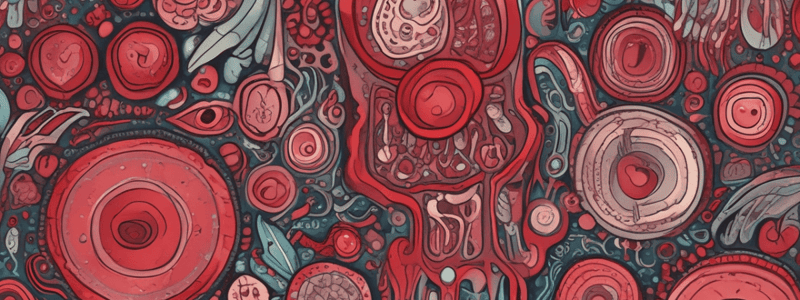Podcast
Questions and Answers
What is the primary objective of assessing anemia?
What is the primary objective of assessing anemia?
- To classify and explain anemia (correct)
- To calculate blood indices
- To diagnose polycythemia
- To recognize the causes of anemia
What are the normal values of blood indices used for?
What are the normal values of blood indices used for?
- Assessing the effectiveness of treatment
- Calculating the severity of anemia (correct)
- Differentiating between types of anemia
- Diagnosing polycythemia
What is polycythemia?
What is polycythemia?
- A type of anemia
- A symptoms of anemia
- A blood disorder characterized by an increase in red blood cells (correct)
- A cause of anemia
What is the main difference between anemia and polycythemia?
What is the main difference between anemia and polycythemia?
What is the primary focus of differentiating between types of anemia?
What is the primary focus of differentiating between types of anemia?
What type of anemia is characterized by normal size and color of red blood cells?
What type of anemia is characterized by normal size and color of red blood cells?
Which of the following is a potential risk of excessive X-ray usage?
Which of the following is a potential risk of excessive X-ray usage?
What is a common association with normochromic anemia?
What is a common association with normochromic anemia?
Which of the following is NOT a potential cause of anemia?
Which of the following is NOT a potential cause of anemia?
What is the term for anemia characterized by normal red blood cell size and color?
What is the term for anemia characterized by normal red blood cell size and color?
What is a characteristic of microcytic anemia?
What is a characteristic of microcytic anemia?
What is a cause of normocytic normochromic anemia?
What is a cause of normocytic normochromic anemia?
What is a characteristic of hypochromic anemia?
What is a characteristic of hypochromic anemia?
What is a cause of megaloblastic anemia?
What is a cause of megaloblastic anemia?
What is a characteristic of erythroblastosis fetalis?
What is a characteristic of erythroblastosis fetalis?
What is a characteristic of hypersegmented RBCs?
What is a characteristic of hypersegmented RBCs?
Which of the following diseases is associated with hookworms?
Which of the following diseases is associated with hookworms?
What is chloramphenicol commonly associated with?
What is chloramphenicol commonly associated with?
Which of the following is a possible cause of peptic ulcer?
Which of the following is a possible cause of peptic ulcer?
What is the relationship between Bilharziasis and hookworms?
What is the relationship between Bilharziasis and hookworms?
Which of the following is NOT a type of disease caused by parasites?
Which of the following is NOT a type of disease caused by parasites?
What is the major cause of anemia leading to breathlessness and racing heart?
What is the major cause of anemia leading to breathlessness and racing heart?
Which type of anemia is characterized by pale skin?
Which type of anemia is characterized by pale skin?
What is a common symptom of iron deficiency anemia?
What is a common symptom of iron deficiency anemia?
Which of the following is NOT a type of anemia?
Which of the following is NOT a type of anemia?
What is the term for anemia characterized by small, pale red blood cells?
What is the term for anemia characterized by small, pale red blood cells?
What is the major cause of anemia leading to fatigue, weakness, and tiring easily?
What is the major cause of anemia leading to fatigue, weakness, and tiring easily?
Which type of anemia is characterized by normal-sized red blood cells?
Which type of anemia is characterized by normal-sized red blood cells?
What is the term for anemia characterized by large, red blood cells?
What is the term for anemia characterized by large, red blood cells?
Flashcards are hidden until you start studying
Study Notes
Anemia
- Anemia is a condition characterized by decreased Hb content, RBCs count, and PCV (HCT value)
- Types of anemia:
- Microcytic hypochromic: smaller size, less hemoglobin
- Normocytic normochromic: normal Hb content, normal RBCs size
- Megaloblastic or macrocytic: hypersegmented RBCs
- Causes of anemia:
- Microcytic hypochromic: iron deficiency, Bilharziasis, hookworms, peptic ulcer, cancer
- Normocytic normochromic: acute blood loss, Erythroblastosis fetalis, enzymatic defect (G6PD deficiency)
- Megaloblastic or macrocytic: folic acid (folate) or vitamin B12 deficiency
- Symptoms of anemia:
- Breathlessness
- Racing heart or palpitations
- Fatigue
- Weakness
- Tiring easily
- Pale skin
Polycythemia
- Polycythemia is a condition characterized by excessive RBCs
- Physiological consequences of polycythemia:
- Increased blood viscosity
- Increased risk of blood clots
- Causes of polycythemia:
- Unclear, but may be related to excessive X-ray usage, cancer, and chloramphenicol use
Studying That Suits You
Use AI to generate personalized quizzes and flashcards to suit your learning preferences.




